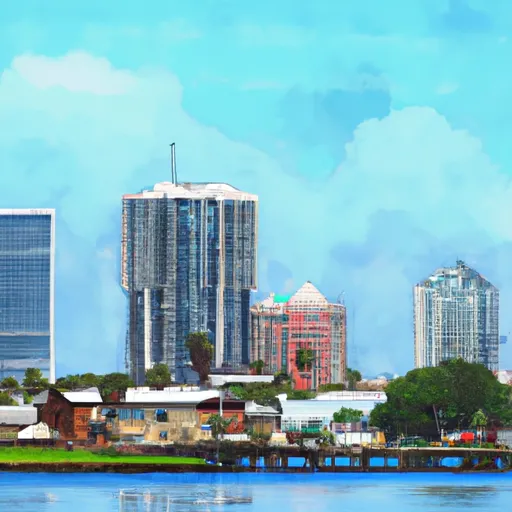-
 Snoflo Premium
Snoflo Premium
Get unlimited access to all our content
With no Ad interruptions! - Start Your Free Trial Login with existing account
Indian-Harbor-Be
Eden Index
Climate
6.8
•
Recreation
4.8
•
Community
3.3
•
Safeguard
5.2/10

Indian Harbor Beach is a charming coastal city located in Brevard County, Florida. Known for its picturesque beaches and tranquil atmosphere, it offers a delightful climate and a variety of outdoor recreational opportunities for residents and tourists alike. The city experiences a subtropical climate, characterized by hot and humid summers and mild, pleasant winters.
The hydrology constituents of Indian Harbor Beach are influenced by its proximity to the Atlantic Ocean and the Indian River Lagoon. The lagoon provides a habitat for diverse marine life, making it a popular spot for fishing, boating, and kayaking. The city is also home to numerous canals and waterways, providing opportunities for water-based activities.
Outdoor enthusiasts can take advantage of the city's serene beaches, ideal for sunbathing, swimming, and beachcombing. Indian Harbor Beach is also renowned for its well-maintained parks, which offer walking and biking trails, picnic areas, and sports facilities. Nearby nature preserves and wildlife sanctuaries provide opportunities for birdwatching and nature exploration.
In conclusion, Indian Harbor Beach, Florida, offers a pleasant climate, diverse hydrology constituents, and a range of outdoor recreational activities that cater to nature lovers and adventure seekers.
What is the Eden Index?
The Snoflo Eden Index serves as a comprehensive rating system for regions, evaluating their desirability through a holistic assessment of climate health, outdoor recreation opportunities, and natural disaster risk, acknowledging the profound impact of these factors on livability and well-being.
Climate Health Indicator (CHI): 6.8
Indian-Harbor-Be receives approximately
1294mm of rain per year,
with humidity levels near 85%
and air temperatures averaging around
23°C.
Indian-Harbor-Be has a plant hardyness factor of
10, meaning
plants and agriculture in this region tend to thrive here all year round.
By considering the ideal temperature range, reliable water supplies, clean air, and stable seasonal rain or snowpacks, the Climate Health Indicator (CHI) underscores the significance of a healthy climate as the foundation for quality living.
A healthy climate is paramount for ensuring a high quality of life and livability in a region, fostering both physical well-being and environmental harmony. This can be characterized by ideal temperatures, reliable access to water supplies, clean air, and consistent seasonal rain or snowpacks.
Weather Forecast
Streamflow Conditions
East Florida Coastal
Area Rivers
East Florida Coastal
Snowpack Depths
East Florida Coastal
Reservoir Storage Capacity
East Florida Coastal
Groundwater Levels
Recreational Opportunity Index (ROI): 4.8
The Recreational Opportunity Index (ROI) recognizes the value of outdoor recreational options, such as parks, hiking trails, camping sites, and fishing spots, while acknowledging that climate plays a pivotal role in ensuring the comfort and consistency of these experiences.
Access to outdoor recreational opportunities, encompassing activities such as parks, hiking, camping, and fishing, is crucial for overall well-being, and the climate plays a pivotal role in enabling and enhancing these experiences, ensuring that individuals can engage in nature-based activities comfortably and consistently.
Camping Areas
| Campground | Campsites | Reservations | Toilets | Showers | Elevation |
|---|---|---|---|---|---|
| Wickham Park | 88 | 31 ft | |||
| Manatee Cove Military - Patrick AFB | None | 6 ft | |||
| Manatee Hammock Park | 177 | 18 ft | |||
| Donald MacDonald Campgrounds | 29 | 15 ft | |||
| Sebastian Inlet State Park | None | 5 ft | |||
| Jetty Park | 150 | 9 ft |
Catastrophe Safeguard Index (CSI):
The Catastrophe Safeguard Index (CSI) recognizes that natural disaster risk, encompassing floods, fires, hurricanes, and tornadoes, can drastically affect safety and the overall appeal of an area.
The level of natural disaster risk in a region significantly affects safety and the overall livability, with climate change amplifying these risks by potentially increasing the frequency and intensity of events like floods, fires, hurricanes, and tornadoes, thereby posing substantial challenges to community resilience and well-being.
Community Resilience Indicator (CRI): 3.3
The Community Resilience Indicator (CRI) recognizes that education, healthcare, and socioeconomics are crucial to the well-being of a region. The CRI acknowledges the profound impact of these elements on residents' overall quality of life. By evaluating educational resources, healthcare accessibility, and economic inclusivity, the index captures the essential aspects that contribute to a thriving community, fostering resident satisfaction, equity, and social cohesion.

